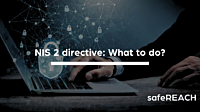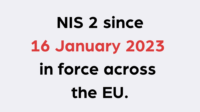NIS 2.0 Directive – Comprehensive guide on NIS 2

Digital networking and cybersecurity are increasingly in the spotlight, making the updated EU NIS 2 Directive (also known as NIS 2.0) a decisive step towards strengthening security standards across Europe. The NIS 2 Directive, as an extension and deepening of the original NIS Directive, addresses the constantly growing challenges in the area of cyber security.
1.666 alarms per second
safeREACH as your powerful emergency notification system with up to 100.000 alarms per minute. Successfully used by multinational corporations, medium-sized companies and public authorities. ISO-certified server infrastructure.

This article provides you with a comprehensive insight into the NIS 2.0 directive, its importance, the main changes compared to its predecessor, but when NIS 2 is valid and how organisations can prepare for it. It is aimed at all stakeholders, from IT professionals to business leaders, who need an in-depth understanding of this new directive and its impact on the business world.
What is NIS 2 and why is it important?
The NIS 2 Directive is the revision of the original Network and Information Security (NIS) Directive and aims to improve security standards for networks and information systems across the European Union. At a time when the volume and complexity of cyber-attacks are increasing, NIS 2.0 is a response to the urgent need to implement standardised and robust security measures across Europe.
It is a crucial step in strengthening resilience to cyber threats and consolidating trust in the digital economy. The importance of NIS 2.0 lies in its comprehensive approach, which covers not only technical aspects, but also organisational and regulatory facets of network and information security. By introducing stricter regulations and clearly defined security standards, NIS 2.0 sets new standards for the protection of critical infrastructures and digital services in Europe.
More information on the topic "Why was it necessary to adapt NIS to NIS 2?" can be found on the page linked here.
Over 20 years of experience in alerting
IT alerting, fire alarms, alerting company first responders and much more. ISO-certified server infrastructure. Used by SMEs, corporations, authorities and public organisations.


Validity and deadlines of NIS 2.0
The NIS 2 Directive came into force in the European Union on 16 January 2023. All EU member states must transpose this directive into national law within 21 months of its entry into force. This means that implementation must be completed by October 2024 at the latest. More information can be found on the website of the European Commission.Main changes and enhancements through NIS 2
NIS 2.0 introduces significant innovations and enhancements aimed at making European infrastructure and digital services more resilient to cyberattacks. These changes include the extension of the scope, the introduction of stricter security requirements, the implementation of reporting obligations for cybersecurity incidents and the establishment of higher fines for non-compliance. These changes reflect the need to strengthen security measures and ensure a high level of cyber resilience in various sectors of the economy.
One particularly important aspect is the extension of the scope, which now includes small and medium-sized enterprises that may not previously have been directly covered by the original NIS Directive. This extension recognises that in our interconnected world, smaller players also play an important role in the supply chain and therefore also represent potential targets for cyber-attacks. In addition, the stricter security requirements and reporting obligations emphasise the importance of a proactive approach to cyber security and encourage companies to continuously monitor and improve their security protocols.
1.666 alarms per second
safeREACH as your powerful emergency notification system with up to 100.000 alarms per minute. Successfully used by multinational corporations, medium-sized companies and public authorities. ISO-certified server infrastructure.

Affected sectors and newly added sectors under NIS 2.0
The update of the NIS Directive to NIS 2.0 brings with it a significant expansion of the scope of application, affecting both traditional and new digital sectors of the European economy. Originally, the NIS Directive focussed on sectors that were considered essential to critical infrastructure, such as energy providers, transport, banking and healthcare. These sectors continue to be of central importance as they are the cornerstones of physical and economic security in Europe.
However, with the introduction of NIS 2.0, the scope will be significantly expanded to include important digital services such as cloud computing providers, social networks, online marketplaces and search engines. This extension recognises that digital services are increasingly becoming an integral part of critical infrastructure and are therefore exposed to an increased risk of cyber-attacks.
The inclusion of these digital services in the NIS 2 Directive is a response to the increasing importance of the digital space for the European economy and society. It reflects the realisation that disruptions or failures in these areas can have a significant impact on everyday life and economic stability. In addition, the focus of NIS 2.0 has expanded to include sectors that were not previously explicitly considered part of critical infrastructure but are now recognised as crucial to the security and well-being of society, such as educational institutions and the public administration sector.
Over 20 years of experience in alerting
IT alerting, fire alarms, alerting company first responders and much more. ISO-certified server infrastructure. Used by SMEs, corporations, authorities and public organisations.

Compliance requirements under NIS 2.0
The NIS 2.0 directive places extensive compliance requirements on the companies and organisations concerned. In addition to the implementation and maintenance of advanced security technologies, these requirements also include regular risk assessments, the development and implementation of emergency plans and compliance with strict data protection regulations. Organisations are required to understand security incident reporting obligations and implement appropriate internal procedures and policies.
These requirements should be seen not only as a response to potential threats, but also as part of a proactive security strategy aimed at building resilience to cyber threats and increasing stakeholder confidence in the security and reliability of services. For many organisations, this means a comprehensive review and adaptation of their existing security protocols and infrastructure. Aspects such as employee training, security awareness and the involvement of external expertise are of crucial importance. Compliance with these requirements is not only important from a legal perspective, but is also a key factor in maintaining a company's reputation and building trust with customers and partners.
1.666 alarms per second
safeREACH as your powerful emergency notification system with up to 100.000 alarms per minute. Successfully used by multinational corporations, medium-sized companies and public authorities. ISO-certified server infrastructure.

Impact on business activities
Adapting to the requirements of NIS 2 can have a major impact on the business activities of affected companies. This includes potential investments in new security technologies, adjustments to IT infrastructure and cyber security training. These measures are crucial to minimise cyber risks, increase customer confidence in the security of their data and ensure business continuity.
It is important that organisations see these requirements not only as a burden, but also as an opportunity to strengthen their resilience to cyber threats and position themselves as trusted and secure partners in the market. For many companies, this can also be an opportunity to rethink and optimise their business processes, as improved cyber security often goes hand in hand with more efficient and secure business operations.
In addition, compliance with the NIS 2 directive can also be used as a competitive advantage by emphasising it to customers and partners as a sign of commitment to the highest security standards. Investing in cyber security and compliance is therefore also an investment in the future viability and sustainable growth of the company.
Over 20 years of experience in alerting
IT alerting, fire alarms, alerting company first responders and much more. ISO-certified server infrastructure. Used by SMEs, corporations, authorities and public organisations.

Best practices and recommendations
To ensure compliance with the NIS 2.0 directive, it is recommended to follow best practices in the area of network and information security. These include regular security audits, ongoing cybersecurity awareness training for employees, working with qualified security experts and developing a strong internal culture of security.
These best practices are not only important to ensure compliance with legal requirements, but also to establish a comprehensive security culture within the organisation. A strong security culture helps to raise awareness of security risks, influence employee behaviour and ultimately strengthen the company's resilience to cyber threats.
Training & further education for the necessary knowledge
Regular training and education is essential to ensure that all employees, regardless of their position and role in the organisation, have the necessary knowledge and skills to recognise potential threats and respond appropriately. Working with external experts and consultants can provide additional valuable insight and expertise, particularly in areas where internal expertise may be limited. Implementing best practices is thus an essential step in continuously improving security standards and adapting to the ever-changing cyber threat landscape.
1.666 alarms per second
safeREACH as your powerful emergency notification system with up to 100.000 alarms per minute. Successfully used by multinational corporations, medium-sized companies and public authorities. ISO-certified server infrastructure.

Future outlook and trends
The network and information security landscape is constantly evolving, and with it the challenges and opportunities that arise for companies. New technologies such as artificial intelligence, the Internet of Things and cloud computing bring with them new dynamics and risk factors that need to be taken into account in security planning.
Companies must continuously adapt their security strategies to these developments in order to ensure protection against evolving threats and at the same time benefit from new technological opportunities. The increasing connectivity and digitalisation of all areas of life is leading to an increasingly complex and integrated cyber security landscape where traditional security approaches may no longer be sufficient. Organisations must therefore be able to react quickly to new threats, continuously monitor and adapt their security systems and take preventative measures to close potential security gaps.
The role of AI in cyber security is expected to become increasingly important as it enables companies to efficiently analyse large amounts of data, detect anomalies and implement automated defence measures. At the same time, the use of AI also brings with it new risks, such as the possibility of manipulated algorithms or data protection challenges. Companies are therefore faced with the task of evaluating both the opportunities and risks of the latest technological developments and adapting their security strategies accordingly.
